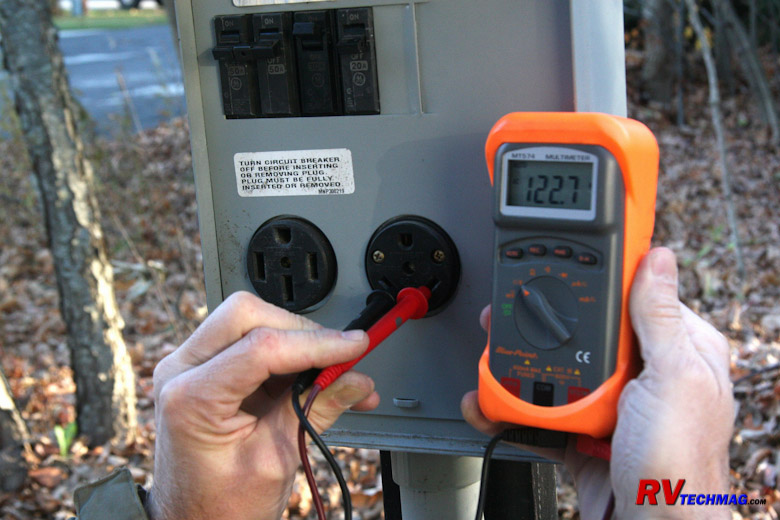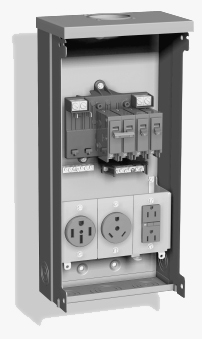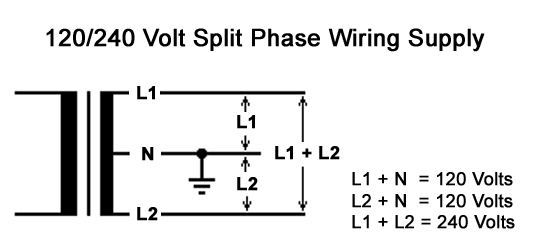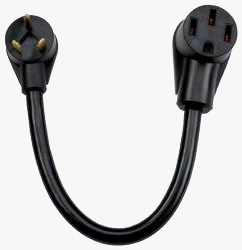|
RV Electrical Tutorial

Chapter 3 - 30 Amp versus 50 Amp
Most modern motorhomes come with a 50 amp service while older motorhomes came with 30 amp services, as did
many of the smaller towable RVs. Over the years a lot of amenities have been added to RVs. As washer-driers, multiple air
conditioners, larger refrigerators, etc are added the power requirements also increase. Most RV parks are attempting to upgrade
their electric supply. Sometimes certain areas are set aside with 50 amp service while others still have 30 and sometimes
the entire park is switched over. Because there needs to be compatibility with all RVs a multi-outlet pedestal is usually
installed that will supply a 50 amp service, a 30 amp service, and even a 20 amp duplex receptacle for the smallest power
requirements. A cutaway image of a typical power pedestal is shown below.

RV Pedestal
In the above pedestal image we can see three separate outlets. From left to right they are 50 amp, 30 amp, and
20 amp. Each receptacle has its own dedicated breaker sized for that particular outlet. This gives the RVer the choice off
choosing whichever outlet they need to best match their RV's electrical service. But, before we delve into the available services
we need to understand what a split-phase service is.

When you create electrical power there is always a pair of windings in the generator that power is taken from. This
is true whether it's a small portable generator, a large diesel powered RV generator, or the huge generator at your local power
utility. These two windings are connected together in series and a tap is run into their common center connection. In the above
diagram we can see that the ends of these windings are identified as L1 and L2. The common center tap of these two windings is
identified as N. L1 and L2 are the hot leads brought into your breaker panel at home and each is generally referred to as a "phase".
The N is the Neutral wire that goes to the neutral buss connection in your breaker panel. This is exactly the same way that your RV's
breaker panel is configured. If you put a voltmeter across lines L1 and L2 you'll see 240 volts. But if you test L1 to N or L2 to N
you'll see 120 volts. Typical breaker panels are wired so that every other slot is on a different phase. The hot lead runs to whatever
device you have on that circuit and the white neutral wire returns back to your panel's neutral buss bar and you have a 120 volt
circuit. If you put a two pole breaker in you'll be grabbing one of each phase so that 240 volts is sent to and from that device.
240 volt devices don't require a neutral wire because the power runs from L1 to L2.
So just how does this power flow? Remember earlier we talked about how AC power just shuttles back and forth? Well all
of the power in this panel leaves one phase and returns to the other. This is easy to understand if it's a 240 volt load because the
power leaves L1 and goes to L2 but it's not as readily apparent when on 120 volts because the neutral can be misleading. With 120 volt
circuits the power leaves one breaker, for example the L1 pole, and travels to the load. It returns via the white neutral wire
to the neutral buss bar. If this is the only thing running that current will then get drained back to the power utility via the
service's neutral wire. But, if there are loads running that reside on the other side of the breaker panel, then this is not true.
Electricity always follows the path of least resistance. In the case of an electrical service it always tries to go
between L1 and L2 whenever possible. If you have a 20 amp load on a 120 volt L1 breaker and a 15 amp load on a 120 volt breaker on L2,
15 amps of power will shuttle back and forth between them. They will be in balance and your ammeter will read 20 amps when testing on
L1. When you test on L2 you'll see 15 amps showing on your meter. If you were to clamp your meter onto the neutral wire you would see
5 amps displayed because the neutral wire only carries the imbalance between L1 and L2. If you had 20 amps running on each phase you
would see zero amps on the neutral line. That's because the AC power tries to shuttle back and forth between L1 and L2. That is what
is called a balanced load. You try to achieve this when locating your breakers into the panel because it minimizes the current flowing
through the power company's electric meter but it's not always possible. If everything was on one side you'd be pulling 40 amps on one
phase, zero on the other, 40 amps on the neutral, and 40 amps on the electric meter so you try to balance things as much as possible.
Okay, now that we know how the breaker panels are normally set up and how the power company sends its power we need to
figure out how this relates to our RV. RV's rarely have any 240 volt items in them. Yet, the newer RVs have 50 amp services, which are
a 120/240 volt split phase system. Before we look at the 50 amp service let's first look at the 30 amp service
30 Amp RV Service:
A 30 amp RV service is really just a glorified 120 volt single pole outlet. Electrical outlets are labeled with a NEMA
code designation. The 30 amp outlet used in an RV application is designated a NEMA TT-30R and the plug is a TT-30P. The TT stands for
Travel Trailer so you won't be finding this outlet in any residential environment. The P and R stand for Plug and Receptacle respectively.
This is a 3 prong plug that consists of a 120 volt hot wire, a neutral wire, and a safety ground wire. The 30 amp RV receptacles do
not use GFCI protection. If you have an older or smaller RV you will have a single pole 30 amp breaker panel where everything is on one
phase. There's no need to split breakers on a 30 amp panel because there is only L1 and 120 volts present. If you need to plug in at a
location where there is no 30 amp RV style outlet you can buy an adaptor at any RV dealer that will adapt your 30 amp RV plug to a standard
15 or 20 amp duplex receptacle. This is the way that RVs were made for many years but with today's modern amenities it has become necessary
to increase the power supply to the newer coaches. Keep in mind that 30 amps times 120 volts equals 3,600 watts and that is how much "stuff"
you can run.
50 Amp RV Service:
To facilitate the larger loads placed upon the newer RVs the 50 amp service was brought out. Whereas the 30 amp service
was a 120 volt service yielding 3,600 watts of power, the 50 amp service is a 120/240 split phase service. The split phase service means
you have two 120 volt 50 amp poles, which gives you a total of up to 12,000 watts. So the perceived increase from 30 to 50 doesn't sound
like very much but the real increase from 3,600 to 12,000 puts it into a more realistic perspective. Keep in mind that this assumes that
you can utilize both of the two 50 amp poles effectively by balancing your load. If all of your loads are on one side of the panel you'll
only be using one 50 amp pole, which means that you can only get 6,000 watts. So, it is important to split your loads and balance them
between both phases on the breaker panel in order to get maximum capacity.
Very rarely will an RV have any 240 volt loads. Some RVs may have 240 volt stackable clothes driers or an electric heating
element of some sort but it's rare. Still, the ability to split the load among two poles means that each pole can handle 50 amps. If all
of the circuits were placed on a single phase, as in the 30 amp service, then you would need a 100 amp service to provide that same
amount of power. That would require some massive wiring to the pedestal and also some very fat and heavy power cords to the RV. 50 amp
lets you get by with a smaller #6 gauge wire. But what happens when you don't have a 50 amp service available?

30 Amp to 50 Amp Dogbone Adaptor
At times it becomes necessary to power an RV with a 50 amp service when there is no 50 amp receptacle available. The standard
50 amp receptacle is a NEMA #1450R. Unlike the 30 amp NEMA TT-30R, this isn't an RV-only receptacle and can be found in industrial applications
as well. It's a 4 prong outlet that has two hot wires - L1 and L2, as well as a neutral and ground wire. Any RV dealer or RV accessory store
will offer an adaptor, that is commonly referred to as a dogbone adaptor, which is illustrated above. This adaptor will let you adapt
your 50 amp plug to a 30 amp so that you can plug your 50 amp RV into a 30 amp RV receptacle if that's all that is available. When you do this
you'll be limited to 30 amps of power though. The dogbone adaptor will connect the single 120 volt hot pole to both the L1 and L2 inputs of
your RV's 50 amp breaker panel. When you do this you will have the same phase across L1 and L2 so there will be no 240 volts available. But,
seeing as how 99.9% of the RVs made don't use anything with 240 volts that's not a problem. In this situation all of the power will be going
down the neutral wire. But, you are only sending 30 amps to the panel and your neutral wire is rated to handle 50 amps so you'll be fine. You
will have to be careful to manage your loads when running on 30 amps. If you fire up all of your air conditioners and water heater you are going
to blow that 30 amp pedestal breaker so you have to watch what you turn on. You can also add a second adaptor to change the 30 amp down to a 20
amp plug if you have to but then all you're going to be able to do is keep the batteries charged and maybe run a few lights
In the next section we'll talk about transfer switches and how they switch between shore power and a generator set.
Index
|



